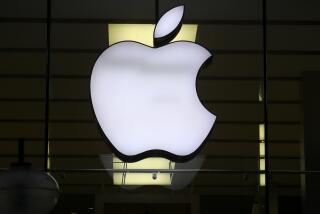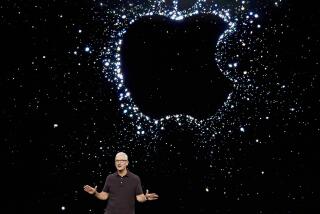New iPhone 5c has analysts talking about possibly poor sales
- Share via
Is the iPhone 5c a rare miss for Apple?
Little over a month after its release, analysts are questioning how well Apple’s new plastic-encased smartphone is faring with consumers.
That scrutiny is being driven by a number of warning signs that have raised the prospect that the 5c might be the first new iPhone to be anything less than a runaway success.
Retailers have already been offering discounts on the phone and several analysts are alleging that Apple has told suppliers to cut back on iPhone 5c parts production. One Verizon Communications executive said Thursday that the iPhone 5c had “undersold expectations.” And although the pricier iPhone 5s remains hard to find, the 5c appears to be readily available just about everywhere.
With Apple being Apple — it keeps sales figures close to its vest and refuses to comment on the reports — no one can be quite sure how the iPhone 5c is doing.
“The real answer is that no one outside of Apple really knows,” said Carl Howe, a Yankee Group analyst.
Although Apple makes big money selling Macbooks and iPads, the performance of the iPhone remains the closely watched barometer of the company’s success. Barclays Research estimates that the iPhone accounted for 53% of Apple’s revenue for the fiscal year that ended Sept. 30, compared with 19% for the iPad.
When Apple first revealed the iPhone 5c last month, it marked a departure from the company’s usual strategy of releasing one new iPhone at a time.
On Sept. 10, the company debuted the iPhone 5s as its new high-end phone, complete with faster processor, fingerprint scanner and improved camera. But it also rolled out the 5c, which sports a plastic case, comes in five colors but is otherwise largely similar inside to the iPhone 5 that was released a year ago.
“IPhone 5C is beautifully, unapologetically plastic,” Apple design guru Jonathan Ive gushed in a promotional video.
Though the plastic case was expected, the price surprised many analysts. As rumors spread that Apple was making a plastic smartphone, analysts assumed this was the “cheaper” iPhone they had argued the company needed to better compete for first-time buyers of smartphones and customers in emerging markets.
Instead, the 16-gigabyte iPhone 5c costs $99 with a two-year service contract, about $100 less than the 5s, but it’s more expensive than the iPhone 4s, which many carriers were offering free with a contract. Without a contract, the iPhone 5c costs $549, putting it out of reach of many consumers in countries where carriers don’t subsidize the cost of the phone.
Typically, the iPhone 5 would have become the mid-priced phone, but Apple discontinued it.
Apple’s sales efforts since then have seemed to focus on the 5c, which is the subject of television ads. Visitors to the Apple.com website are greeted with a large display of an iPhone 5c with the slogan “For the colorful.” The company also allowed consumers to pre-order the 5c, but not the 5s.
The strategy of releasing two new phones seemed to pay dividends when the company announced it had sold 9 million new iPhones the first weekend, blowing past all expectations and the previous record of 5 million, set a year ago.
However, Apple counts a phone as sold when it’s delivered to a partner such as Best Buy or AT&T Wireless. Some analysts estimated that 2 million to 3.5 million of those 9 million iPhones were not sold to customers that first weekend and were sitting at retail stores.
After the first weekend, the iPhone 5s became hard to find in stores, and Apple’s website continues to project several weeks to deliver one. By contrast, the 5c has remained widely available, with the website offering to ship one in 24 hours.
Within a couple of weeks of its debut, Best Buy and Wal-Mart were offering discounts on the iPhone 5c.
First, Best Buy announced a promotion that gave a $50 gift card to customers who bought the iPhone 5c at a store. That gift card could be used at the time of the sale to cut the price of the iPhone 5c with 16 gigabytes of memory from $99.99 to $49.99.
Then Wal-Mart tried to top that by cutting the price of the iPhone 5c to $45 with a two-year contract. Wal-Mart had been selling the device for $79.
Best Buy then turned around and offered a trade-in promotion running this weekend. The store will give anyone $100 for his or her old smartphone that could be used to buy the iPhone 5c or iPhone 5s.
When asked for comment about sales of the iPhone 5c, Best Buy spokesman Jon Sandler said he couldn’t speak for Apple, but reiterated that the trade-in promotion, which runs through Saturday, was for the 5c and 5s.
Meanwhile, several reports suggest consumers have been buying the iPhone 5s in much greater numbers than the 5c. Consumer Intelligence Research Partners reported that 64% of iPhones sold over the last month were the 5s, compared with 27% for the 5c.
“This result confirms anecdotal reports that the flagship iPhone 5s outsold the lower-priced iPhone 5c. CIRP data indicates that it did so by over two-to-one in the two weeks following the launch,” Josh Lowitz, partner and co-founder of the firm, said in the report.
Of course, typically the newest, priciest iPhone accounts for most sales initially as early adopters grab it. Last year at the same point, CIRP reported that the new iPhone 5 accounted for 68% of iPhone sales while the 4s was 23% of sales.
Adding to the 5c questions, KGI Securities analyst Ming-Chi Kuo recently lowered his estimate for iPhone 5c sales through the end of September by 33% to 11.4 million. And he now projects only 10.4 million iPhone 5c units to be sold the next three months.
Jefferies & Co. analyst Peter Misek also predicted in a recent note to clients that Apple would eventually have to slash the price for the 5c because of poor sales.
Brian White, an analyst at Cantor Fitzgerald, sent a note to clients summarizing a recent visit to Apple suppliers in China and Taiwan, indicating that the 5c did not appear to be terribly popular.
“The data points at the China-based carriers and retailers this week have highlighted soft demand for the iPhone 5c,” White wrote. “As such, we believe orders for the iPhone 5c in the supply chain will need to be reduced in the future.”
After release of its earnings Thursday, Verizon executives added to the iPhone 5c doubts.
In an interview with Reuters, Verizon Chief Financial Officer Fran Shammo said the iPhone 5c “undersold expectations.” He said that “5c is in plenty supply” and that “if you generally talk to each of the carriers I think they’ll tell you the same thing.”
Of course, reading such signals among Apple’s suppliers is always tricky. And earlier this year, during an earnings call with analysts, Apple Chief Executive Tim Cook said drawing any conclusions was a mistake.
“I suggest it’s good to question the accuracy of any kind of rumor about build plans,” Cook said. “Even if a particular data point were factual, it would be impossible to interpret that data point as to what it meant to our business.”
At the same time, there are indications the iPhone 5c might be doing OK.
In the CIRP report, Lowitz said he expected a higher percentage of 5c units to be sold as early adopters who rushed out to grab the 5s gave way to more price-conscious mainstream buyers. During a recent visit to an AT&T wireless store in San Francisco, an employee said they had only the more expensive 32GB iPhone 5c available and then only in a couple of colors.
That’s not unusual, according to Will Power, a Robert W. Baird research analyst. In a note to clients this week, Power said that although consumers can easily find some version of the iPhone 5c, many stores were also out of versions.
“This implies that while the iPhone 5C is easily found, its inventory is not sitting stagnant,” he wrote.
If Apple is stumbling, investors don’t seem too worried. On Thursday, Apple’s stock closed at $504.50, up 6% since the beginning of the month.
More to Read
Inside the business of entertainment
The Wide Shot brings you news, analysis and insights on everything from streaming wars to production — and what it all means for the future.
You may occasionally receive promotional content from the Los Angeles Times.










